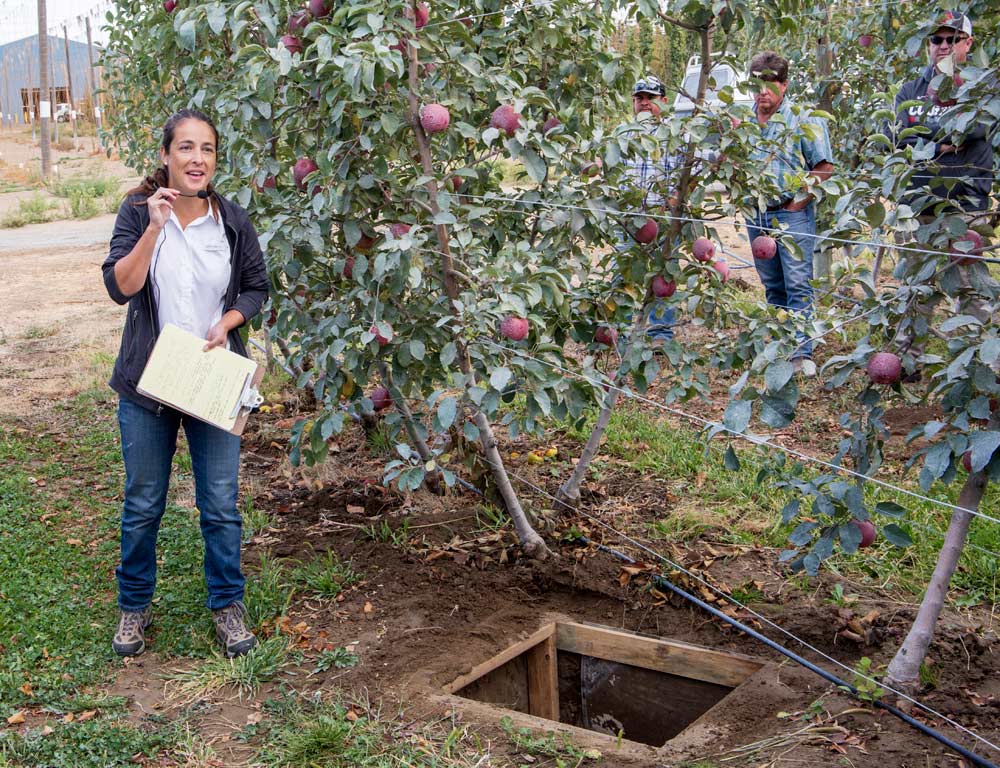
Bernardita Sallato, a Washington State University tree fruit extension specialist, leads a portion of a WA 38 field day tour in September at the university’s Roza research orchard near Prosser. She discussed rootstocks, soils, and her prototype rootzone window, a square hole in the ground buffered by acrylic panes that let her monitor root development. (Ross Courtney/Good Fruit Grower)
Green spot was not the only topic of conversation at preharvest Cosmic Crisp field days held in September at Washington State University’s research orchards near Wenatchee and Prosser.
Researchers also riffed about fire blight, rootstocks, starch scales and more. Here are a few nuggets from Ines Hanrahan of the Washington Tree Fruit Research Commission and WSU’s Karen Lewis, Stefano Musacchi and Bernardita Sallato.
—Fire blight took a hefty toll in the Roza orchard due to a hailstorm and lack of control last year. Lewis had planned some drape net trials but changed her mind, figuring the netting would make it harder for her to monitor for fire blight strikes. As a result, she also hedged later than usual — July 13, the first day temperatures reached 100 degrees to avoid spreading fire blight. That late hedging exposed fruit later in the summer than usual and led to sunburn.
—The fire blight infections may point to a rootstock lesson. The damage disproportionately affected trees growing on Malling 9 Nic 29 rootstocks when compared to Geneva 41 rootstocks, Sallato told attendees at the Prosser orchard. A total of 25 percent of the trees in the orchard growing on Nic 29 rootstocks were removed, while only 2 percent of the G.41-rooted trees were removed. However, Sallato cautioned, some of the trees may have been removed for reasons other than fire blight prior to 2018. She joined the extension team in the summer of 2017. The damage was quite visible; stumps from removed trees dotted the rows. The infection often caused entire trees to wilt but did not always show up in specific branches or blooms, Sallato said.
—Interestingly, Nic 29 roots performed well at Sunrise, which has not shown fire blight pressure. There, Cosmics on Nic 29 roots appear to have less vigor and more fruit with better color than their G.41 counterparts, Musacchi said.
—Start picking Cosmics no earlier than 2 on a 1-6 starch scale, Hanrahan said. Once starch starts clearing out of the core, it typically moves slowly and evenly at a rate of 1 point per 10 days, meaning the harvest window should be rather wide, she said. Researchers consider the Cosmic a one-pick variety.
—To get the most accurate starch test, cut through the dead center of the Cosmic’s vertical axis to expose the center of the seed cavity, Hanrahan said. That’s unusual. In other varieties, growers should aim for slightly above center.
—Consider clipping stems. Tests bins without clipping had 5 percent puncture damage, while those with clipped fruit had only 2 percent, Hanrahan said.
—When picking, warn crews to be careful to not pull off spurs. They detach easily and also can puncture fruit in the bin. •
-by Ross Courtney
Related story: Cosmic conundrum: Researchers target green spot disorder on Cosmic Crisp






Leave A Comment